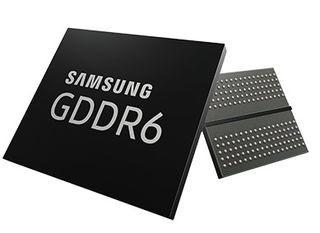
Samsung has beaten SK Hynix and Micron to be the first to mass produce GDDR6 memory chips. Samsung’s 16Gb (2GB) chips are fabricated on a 10nm process and run at 1.35V. The new chips have a whopping 18Gb/s pin speed and will be able to reach a transfer rate of 72GB/s. Samsung’s current 8Gb (1GB) GDDR5 memory chips, besides having half the density, work at 1.55V with up to 9Gb/s pin speeds. In a pre-CES 2018 press release, Samsung briefly mentioned the impending release of these chips. However, the speed on release is significantly faster than the earlier stated 16Gb/s pin speed and 64GB/s transfer rate.
As for the aforementioned competition, SK Hynix released details of its GDDR6 chips about half a year ago, while Micron said its chips were on track for mass production sometime this year. SK Hynix’s first GDDR6 chip was said to be an 8Gb, 16Gb/s chip that also runs at 1.35V. A 16Gb chip was planned for later release. Micron never detailed a specific chip but predicted that its GDDR6 chips would start at 12Gb/s, about the same speed as its current fastest GDDR5X chips, before also eventually reaching 16Gb/s, too.
We’ll have to wait for Samsung’s chips to reach some GPUs before we’ll know whether they’re actually able to run at speeds that beat what both competitors have said they hope to hit.
For comparison’s sake, the GTX 1080, which released with 10Gb/s GDDR5X, had a memory bandwidth of 320GB/s on a 256-bit bus. The same card with 16Gb/s and 18Gb/s memory would have a memory bandwidth of 512GB/s and 576Gb/s, respectively. This bandwidth would put it in the territory of the current Titan Xp, which runs on 11.4Gb/s GDDR5X but has a 50% wider bus.
Stay on the Cutting Edge
Join the experts who read Tom's Hardware for the inside track on enthusiast PC tech news — and have for over 25 years. We'll send breaking news and in-depth reviews of CPUs, GPUs, AI, maker hardware and more straight to your inbox.
-
t1gran So we have Samsung's 72 GB/s (32-pin) VS SK Hynix's 768 GB/c (384-pin)? What's the point?Reply -
TadashiTG The 72 GB/s is for a single memory chip. VRAM chips can be accessed in parallel so if you have four of them that's 72*4 = 288 GB/s with a 8GB VRAM card. Or 576 GB/s for a 16GB VRAM card.Reply -
Zaporro Good, now lets hope that GDDR6 will absolutely suck for mining, so dirty miners frik off gaming GPUs.Reply -
AgentLozen How far do you guys think GDDR6 will scale? When GDDR5 came out with the Radeon 4870's back in 2008, it ran at half the speed it does today. Do you suppose in 2022 we'll see GDDR6 with twice the bandwidth that's mentioned here?Reply
Also, what are the odds that GDDR6 will be paired with next gen Volta GPUs or a Vega successor? Is GDDR6 better than HBM2 or 3? Which direction makes more sense for graphics card developers?
Edit:
Did I ask too many questions back there? What can I do to make sure this doesn't happen again? -
grimfox I think HBM2 is still a better fit for compute GPUs as just two packages of HBM have the same bandwidth as an entire 1080 gpu of GDDR6. Both coming in at 512GB/s.Reply
As far as lifetime scaling I feel like the GDDR5 era was longer than previous versions. We should probably expect the GDDR6 era to be equally as long with steady speed improvements throughout. Unless HBM prices drop substantially. Then GDDR6 could fall out of favor. In which case by 2022 GDDR6 could be top out at 18-20GB/s because development basically stops in favor of pushing HBM faster and to higher densities. -
Eximo It will be interesting. A lot of the fabs are getting close to where there will have to be a radical shift in technology before going forward. GDDR5 went through a lot of process node shrinks to keep improving.Reply
And you have the better design that HBM gets you in addition to the much smaller footprint. With the MXM standard supposedly dying, I suspect HBM for mobile graphics is going to become the standard there.
Most Popular



